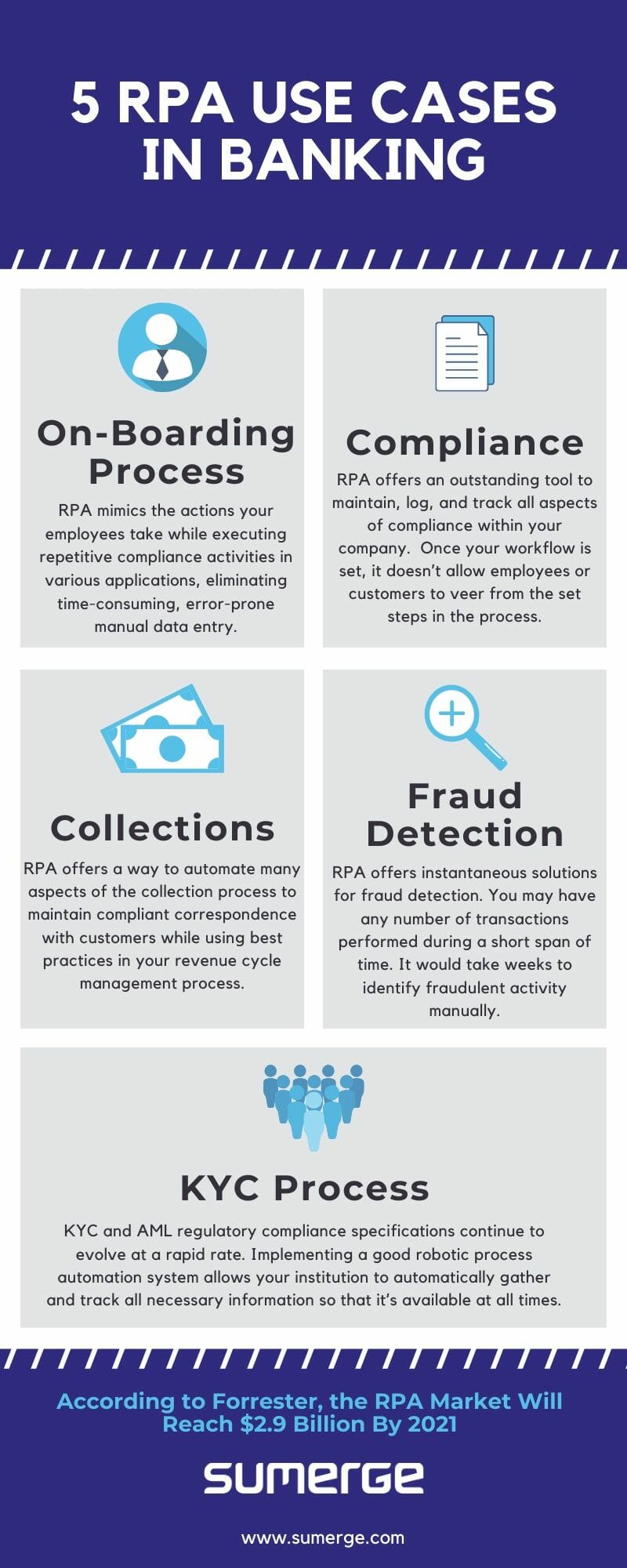
RPA Use Cases in Banking | Where Can I Leverage RPA?
- Posted by Adham Jan
- On May 4, 2020
Robotic Process Automation (RPA)
Robotic Process Automation (RPA) is quickly gaining traction across many industries. According to Forrester, the market will reach $2.9 billion by 2021, with the entirety of the AI market reach at about $48 billion. In this blog about RPA use cases in banking, we will review where you can leverage RPA.
Here are five excellent RPA use cases in banking.

1. Customer On-Boarding Process
This is one area where RPA really excels. In the old-fashioned model of welcoming new customers to your institution, you’d have a personal banker or other employee walk them through process in a lengthy, boring meeting, complete with a folder full of printed pages. While it’s still a good policy to have personnel available for customers, many don’t really want to sit through that meeting. You can streamline that process and put together a digital on-boarding process that gives them access to all the information they need to answer any questions, while gathering all the information your institution needs to meet and exceed their expectations in customer service.
2. Compliance
RPA offers an outstanding tool to maintain, log, and track all aspects of compliance within your company. By its nature, your software solution is set as a workflow. Once your workflow is set, it doesn’t allow employees or customers to veer from the set steps in the process. This means that you’ll eliminate situations where necessary information is incomplete or inaccurate. Internal and external functions will be completed the same way, every time. This improves productivity and efficiency, while reducing errors.
3. Collections
Your institution’s collections department often has a wealth of manual and tedious tasks that take up a great deal of time and effort for staff. RPA offers a way to automate many aspects of this process to maintain compliant correspondence with customers while using best practices in your revenue cycle management process.
4. Fraud Detection
RPA offers instantaneous solutions for fraud detection. You may have any number of transactions performed during a short span of time. It take weeks to identify fraudulent activity manually. You can set RPA to monitor activity that looks suspicious to mitigate losses for the bank and the customers.
5. KYC Process
KYC and AML regulatory compliance specifications continue to evolve at a rapid rate. Implementing a good RPA system allows your institution to automatically gather and track all necessary information so that it’s available at all times. This makes it much simpler to stay in compliance with governing bodies
What is RPA in Banking?
RPA is any technology that helps automate tasks that were once manual. RPA enables banks & finance companies. It will reduce manual efforts, offer better compliance, mitigate risks, and enhance the overall consumer experience. The primary aim of RPA in the banking industry is to assist in processing the banking work that is repetitive.In addition, RPA helps banks increase their productivity by engaging customers in real-time and leveraging the immense benefits of robots.
Automation is certainly not a new idea, RPA processes in banking promise to improve a wide swath of issues, solving pain points that seemed insurmountable in the past. With the growth of solutions and the wide adaptation across the industry. It’s important to make sure that your institution implements best practices. In order to stay competitive and offer optimal customer service.
RPA is a good idea and understanding how to best implement it are two different things. According to PWC, some institutions don’t see the ROI expected from their RPA initiatives. In some cases, they don’t know how to gauge their return. In other cases, institutions can’t adequately identified their pain points prior to implementation.
RPA Use Cases in Banking
A banking robotic process automation use case is defined as the process of documenting a list of banking operations actions. In other words, RPA is used to automate information movement across banking applications. IT consultants use RPA use cases as process “blueprints”to implement automated scripts that run across multiple data-processing IT systems simultaneously.
Before you research and implement software solutions to meet your RPA needs, first you need to identify what you need to improve and what goals you have with the new processes. There is no doubt that institutions need to automate certain functions to stay current. It doesn’t mean you should implement new processes without understanding the end goals.
There are many functions that new software solutions can help automate and streamline. Some are universal to all financial institutions and some are chosen specifically for the pain points that hinder your bank and/or customers.
Are You Considering Adopting RPA?
Send download link to:
RPA is only useful when your institution implements changes to fix or improve set protocols. First you need to identify the areas within your institution that could benefit from better automation.
Interested To Learn More About Robotic Process Automation Solutions? Click Here




